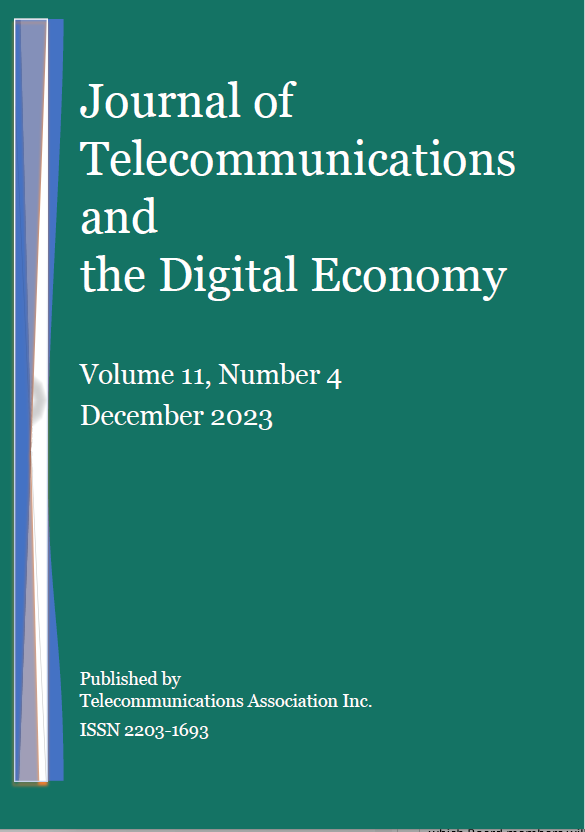Building Trust in Telesurgery through Blockchain-Based Patient Consent and Surgeon Authentication
Main Article Content
Keywords
Telesurgery, Security, Blockchain, Authentication
Abstract
Telesurgery, which enables remote surgical procedures, has the potential to revolutionize healthcare by improving access to specialized care and reducing costs. However, trust in telesurgery is a major concern for patients and healthcare providers. To address this issue, we propose a novel system for building trust in telesurgery through blockchain-based patient consent and surgeon authentication. Our system uses a smart contract on the blockchain to store patient consent and surgeon authentication data, which is securely verified by the telesurgery robot. We present a simulation of our system and evaluate its performance. Our results show that our system can authenticate surgeons and grant patient consent quickly and securely. This system has the potential to increase trust in telesurgery and promote its widespread adoption.
References
Bonaci T., Yan, J., Herron, J., Kohno, T., & Chizeck, H. J. (2015, April). Experimental analysis of denial-of-service attacks on teleoperated robotic systems. In Proceedings of the ACM/IEEE sixth international conference on cyber-physical systems (pp. 11-20). https://doi.org/10.1145/2735960.2735980
Chen, H., Pendleton, M., Njilla, L., & Xu, S. (2020). A survey on Ethereum systems security: Vulnerabilities, attacks, and defenses. ACM Computing Surveys (CSUR), 53(3), 1–43. https://doi.org/10.1145/3391195
Choi, P. J., Oskouian, R. J., & Tubbs, R. S. (2018). Telesurgery: Past, present, and future. Cureus, 10(5), e2716. https://doi.org/10.7759/cureus.2716
DiMaio, S., Hanuschik, M., & Kreaden, U. (2011). The da Vinci Surgical System. In: Rosen, J., Hannaford, B., Satava, R. (eds) Surgical Robotics. Springer, Boston, MA. https://doi.org/10.1007/978-1-4419-1126-1_9
Ethereum (2022). Ethereum development documentation. Ethereum.org. https://ethereum.org/en/developers/docs/
Glezer, A., Stern, T. A., Mort, E. A., Atamian, S., Abrams, J. L., & Brendel, R. W. (2011). Documentation of decision-making capacity, informed consent, and health care proxies: a study of surrogate consent. Psychosomatics, 52(6), 521–529. https://doi.org/10.1016/j.psym.2011.06.006
Guo, H., & Yu, X. (2022). A survey on blockchain technology and its security. Blockchain: Research and Applications, 3, 100067. https://doi.org/10.1016/j.bcra.2022.100067
Hassan, M. U., Rehmani, M. H., & Chen, J. (2019). Privacy preservation in blockchain based IoT systems: Integration issues, prospects, challenges, and future research directions. Future Generation Computer Systems, 97, 512-529. https://doi.org/10.1016/j.future.2019.02.060
Helliar, C. V., Crawford, L., Rocca, L., Teodori, C., & Veneziani, M. (2020). Permissionless and permissioned blockchain diffusion. International Journal of Information Management, 54, 102136. https://doi.org/10.1016/j.ijinfomgt.2020.102136
Houston, L., Probst, Y., Yu, P., & Martin, A. (2018). Exploring data quality management within clinical trials. Applied Clinical Informatics, 09, 072–081. https://doi.org/10.1055/s-0037-1621702
Hylock, R. H., & Zeng, X. (2019). A blockchain framework for patient-centered health records and exchange (healthchain): Evaluation and proof-of concept study. Journal of Medical Internet Research, 21, e13592. https://doi.org/10.2196/13592
Khan, S. N., Loukil, F., Ghedira-Guegan, C., Benkhelifa, E., & Bani Hani, A. (2021). Blockchain smart contracts: Applications, challenges, and future trends. Peer-to-Peer Networking and Applications, 14, 2901–2925. https://doi.org/10.1007/s12083-021-01127-0
Komalavalli, C., Saxena, D., & Laroiya, C. (2020). Overview of blockchain technology concepts. In Handbook of research on blockchain technology (pp. 349-371). Academic Press. https://doi.org/10.1016/B978-0-12-819816-2.00014-9
Li, Y., Hannaford, B., & Rosen, J. (2019). The Raven open surgical robotic platforms: A review and prospect. Acta Polytechnica Hungarica, 16(8), 9–27. http://acta.uni-obuda.hu/Li_Hannaford_Rosen_95.pdf
Mohan, A., Wara, U. U., Shaikh, M. T. A., Rahman, R. M., & Zaidi, Z. A. (2021). Telesurgery and robotics: An improved and efficient era. Cureus, 13(3), e14124. https://doi.org/10.7759/cureus.14124
Murray, M. (2019). Tutorial: A Descriptive Introduction to the Blockchain. Communications of the Association for Information Systems, 45. https://doi.org/10.17705/1CAIS.04525
Pietrzykowski, T., & Smilowska, K. (2021). The reality of informed consent: empirical studies on patient comprehension—systematic review. Trials, 22, 57. https://doi.org/10.1186/s13063-020-04969-w
Sammeta, N., & Parthiban, L. (2022). An optimal elliptic curve cryptography based encryption algorithm for blockchain-enabled medical image transmission. Journal of Intelligent & Fuzzy Systems, (Preprint), 1–13. https://doi.org/10.3233/jifs-211216
Sanda, P., Pawar, D., & Radha, V. (2022). Blockchain-based tamper proof and transparent investigation model for cloud VMs. Journal of Supercomputing, 78, 17891–17919. https://doi.org/10.1007/s11227-022-04567-4
Shah, M., Li, C., Sheng, M., Zhang, Y., & Xing, C. (2020). Smarter Smart Contracts: Efficient Consent Management in Health Data Sharing. In: Wang, X., Zhang, R., Lee, Y. K., Sun, L., & Moon, Y. S. (eds), Web and Big Data. APWeb-WAIM 2020. Lecture Notes in Computer Science, vol. 12318. Springer, Cham. https://doi.org/10.1007/978-3-030-60290-1_11
Simon, A. (2020). Ethical Issues Concerning Patient Autonomy in Clinical Practice. In: Kühler, M., & Mitrović, V.L. (eds), Theories of the Self and Autonomy in Medical Ethics. The International Library of Bioethics, vol. 83. Springer, Cham. https://doi.org/10.1007/978-3-030-56703-3_8
Sriman, B., Ganesh Kumar, S., & Shamili, P. (2021). Blockchain Technology: Consensus Protocol Proof of Work and Proof of Stake. In: Dash, S. S., Das, S., & Panigrahi, B. K. (eds), Intelligent Computing and Applications. Advances in Intelligent Systems and Computing, vol. 1172. Springer, Singapore. https://doi.org/10.1007/978-981-15-5566-4_34
Swende, M. H., & Johnson, N. (2016). Erc-191: Signed data standard. Ethereum Improvement Proposals, 191. https://eips.ethereum.org/EIPS/eip-191
Tamalvanan, V. (2021). Foreseeable challenges in developing telesurgery for low income and middle-income countries. International Surgery Journal, 8, 3228. https://doi.org/10.18203/2349-2902.isj20214033
Tandon, A., Dhir, A., Islam, N., & Mäntymäki, M. (2020). Blockchain in healthcare: A systematic literature review, synthesizing framework and future research agenda. Computers in Industry, 122, 103290. https://doi.org/10.1016/j.compind.2020.103290
Uddin, M., Salah, K., Jayaraman, R., Pesic, S., & Ellahham, S. (2021). Blockchain for drug traceability: Architectures and open challenges. Health Informatics Journal, 27, 146045822110112. https://doi.org/10.1177/14604582211011228
Verma, R., Dhanda, N., & Nagar, V. (2023). Application of Truffle Suite in a Blockchain Environment. In: Singh, P. K., Wierzchoń, S. T., Tanwar, S., Rodrigues, J. J. P. C., & Ganzha, M. (eds), Proceedings of Third International Conference on Computing, Communications, and Cyber-Security. Lecture Notes in Networks and Systems, vol. 421. Springer, Singapore. https://doi.org/10.1007/978-981-19-1142-2_54
Wang, S., Yuan, Y., Wang, X., Li, J., Qin, R., & Wang, F.-Y. (2018). An overview of smart contract: Architecture, applications, and future trends. 2018 IEEE Intelligent Vehicles Symposium (IV), Changshu, China, 2018, pp. 108–113. IEEE. https://doi.org/10.1109/IVS.2018.8500488
Wright, S. A. (2019). Technical and legal challenges for healthcare blockchains and smart contracts. 2019 ITU Kaleidoscope: ICT for Health: Networks, Standards and Innovation (ITU K), Atlanta, GA, USA, 2019, pp. 1–9. IEEE. https://doi.org/10.23919/ITUK48006.2019.8996146






